
Size Check – How to Measure Your Gains Properly
- Written
How to Track Your Physical Progress
How to measure gains properly is essential for anyone serious about fitness, bodybuilding, or personal improvement. To help you get started immediately, here are the four most effective methods:
- Tape Measurements: Measure key body parts (arms, chest, thighs, waist) biweekly using a flexible tape.
- Body Composition: Track body fat percentage and lean mass using scales, calipers, or DEXA scans.
- Strength Progress: Record weights lifted, reps, and sets to monitor performance improvements.
- Progress Photos: Take consistent photos every 2-3 weeks under identical lighting conditions.
Building muscle or achieving any physical improvement requires more than just hard work—it demands objective tracking of your progress. Without proper measurement, you're essentially flying blind, unable to determine if your efforts are yielding results.
Research shows that participants typically gain about 3-4 pounds of fat-free mass over a 12-week training program (roughly 1 pound per month), while arm and thigh circumferences increase by approximately 4-6% over 8-12 weeks. But without tracking these changes, you might miss these significant improvements.
The mirror can lie. Daily visual checks often fail to reveal gradual changes that accumulate over time. That's why systematic measurement using multiple methods provides the objective feedback needed to stay motivated and make informed adjustments to your routine.
I'm John Hanger, President at ZenHanger, where I've helped thousands of clients develop effective strategies on how to measure gains across various physical improvement goals.
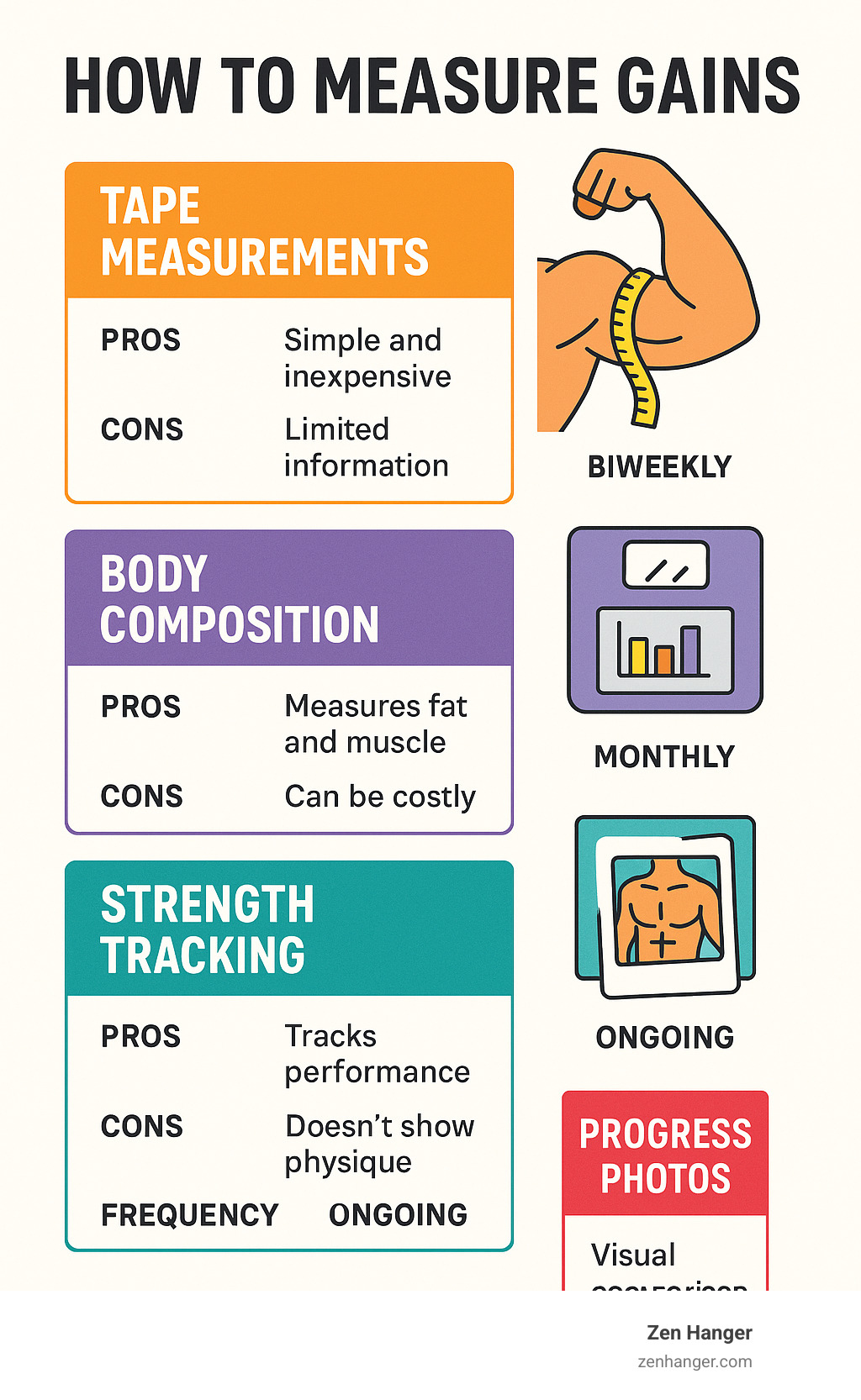
Why Measuring Matters
Measuring your progress isn't just about satisfying curiosity—it's about creating a feedback loop that drives continued improvement. When you measure consistently, you:
- Verify that your program is actually working
- Identify which body parts are responding best to training
- Recognize when progress stalls and adjustments are needed
- Stay motivated by seeing concrete evidence of change
- Set realistic goals based on your actual rate of progress
Without measurement, you're relying on subjective feelings and potentially missing important signals about your development. As the saying goes in fitness circles, "What gets measured gets improved."
How to Measure Gains: Proven Techniques
When it comes to tracking your physical development, one method just isn't enough. Think of it like putting together a puzzle—each measurement technique gives you a different piece, and together they create a complete picture of how your body is changing.
Good news for tape measure fans! Scientific research published in the Journal of Strength and Conditioning Research confirms what many gym-goers already suspected: simple circumference measurements correlate strongly with fancy imaging techniques when tracking muscle growth. This means your humble tape measure is actually one of the most reliable tools in your arsenal.
Let's compare the most popular measurement methods so you can choose what works best for you:
| Method | Accuracy | Accessibility | Cost | Best For |
|---|---|---|---|---|
| Tape Measurements | Moderate-High | Very High | $ | Tracking specific body part growth |
| BIA Scales | Moderate | High | $$ | Tracking trends in body composition |
| Skinfold Calipers | Moderate-High | Moderate | $ | Estimating body fat percentage |
| DEXA Scan | Very High | Low | $$$ | Precise body composition analysis |
| Progress Photos | Moderate | Very High | Free | Visual comparison over time |
| Strength Logs | High | Very High | Free | Performance improvements |
Tape & Circumference: How to Measure Gains in Size
A flexible measuring tape might just become your new best friend. It's affordable, practical, and surprisingly informative when used correctly.
For muscle building, here's how to measure gains in key body areas:
When measuring your arms (biceps), wrap the tape around the widest point with your arm relaxed at your side. Some people prefer a slightly flexed position—just be consistent each time.
For your chest, position the tape at nipple level, wrapping it around your back. Remember to breathe normally and measure at the end of a normal exhale.
Thigh measurements should be taken at the midpoint between your hip joint and knee, or simply at the widest part. The key is consistency in your measurement point each time.
For Zen Hanger customers focusing on personal improvement, proper measurement is equally important. When measuring penile length, the scientific standard is Bone-Pressed Erect Length (BPEL). This involves measuring from the pubic bone to the tip along the top side, which accounts for the fat pad at the base and gives a consistent measurement regardless of weight fluctuations.
For the most accurate tracking, always measure at the same time of day, use the same technique each time, and record everything in a dedicated journal or app. You can learn more about how to take body tape measurements at gymJP.com.
Body-Fat & Lean Mass Calculations
Understanding your body composition helps you know whether weight changes reflect muscle growth or fat gain/loss. This distinction is crucial for anyone serious about fitness.
How to measure gains in lean body mass starts with calculating your body fat percentage. You have several options here: BIA scales, skinfold calipers, the US Navy formula, or a DEXA scan if you're feeling fancy.
Once you know your body fat percentage, calculating your fat mass is simple math—multiply your total weight by your body fat percentage. Your lean mass is everything else—subtract your fat mass from your total weight.
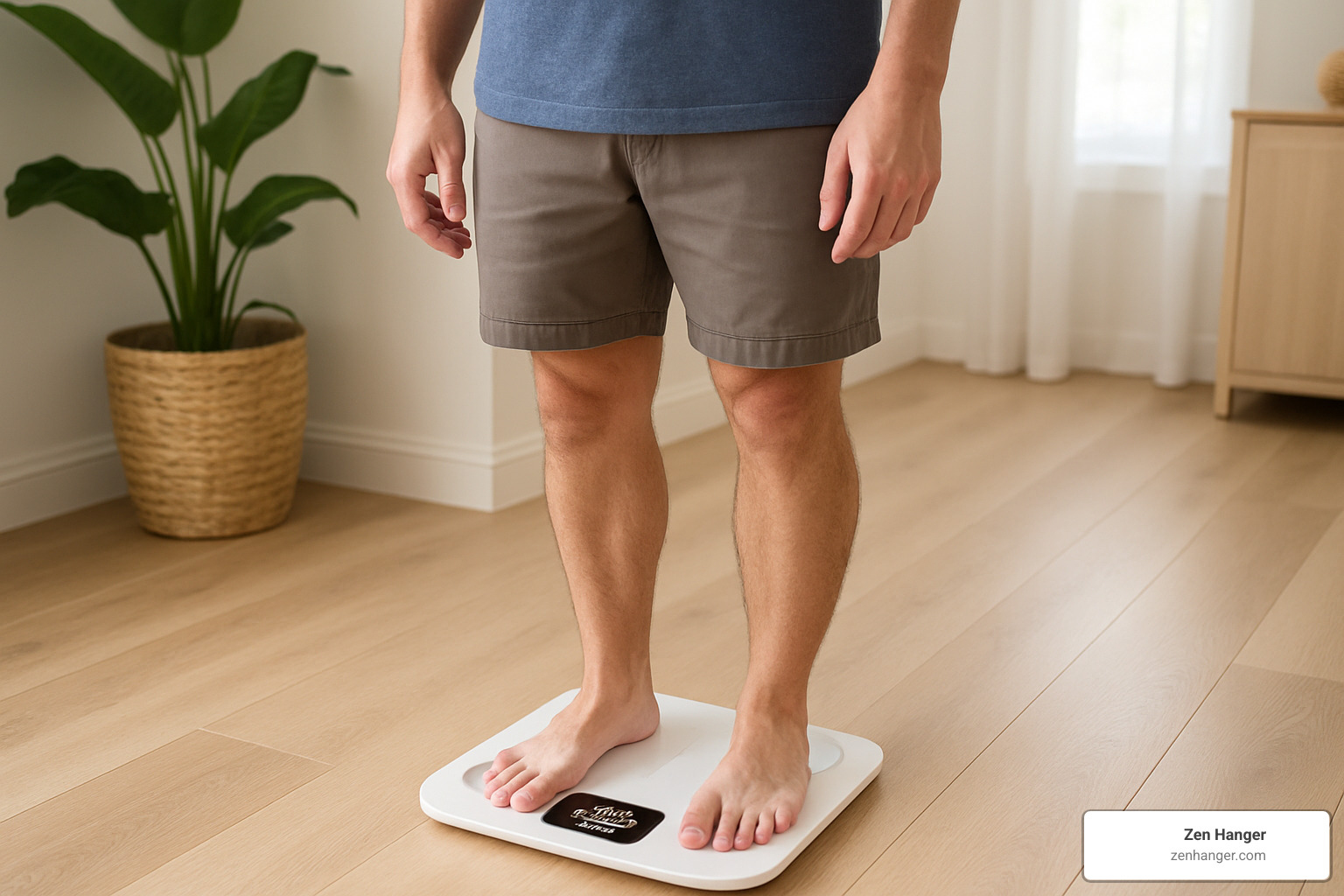
Research published in the Journal of Clinical Densitometry offers good news for those of us who can't afford monthly DEXA scans—consumer body-fat scales can reliably detect changes in body composition over time. They might not be perfect for absolute numbers, but they're great for tracking trends.
Strength Tracking
After the initial "newbie gains" period, strength increases closely correlate with muscle growth. This makes strength tracking one of the most functional ways to measure gains.
Your one-rep max (1RM)—the maximum weight you can lift for a single repetition—is the gold standard of strength measurement. However, testing this too frequently can be taxing on your body. Every 6-8 weeks is plenty.
For a less demanding option, try rep max testing instead. Find the maximum weight you can lift for a specific number of reps (like 5RM or 10RM).
Research with intermediate lifters shows they can expect strength increases of approximately 5-10% per month on a well-designed program. As you become more advanced, this rate naturally slows.
Progress Photos: Visual Proof of How to Measure Gains
Numbers are great, but sometimes seeing is believing. Progress photos offer a powerful visual record of your physical development that measurements alone can't capture.
For the most effective progress photos, take them first thing in the morning on an empty stomach, every 2-3 weeks. Use the same lighting conditions each time—natural, indirect light tends to work best.
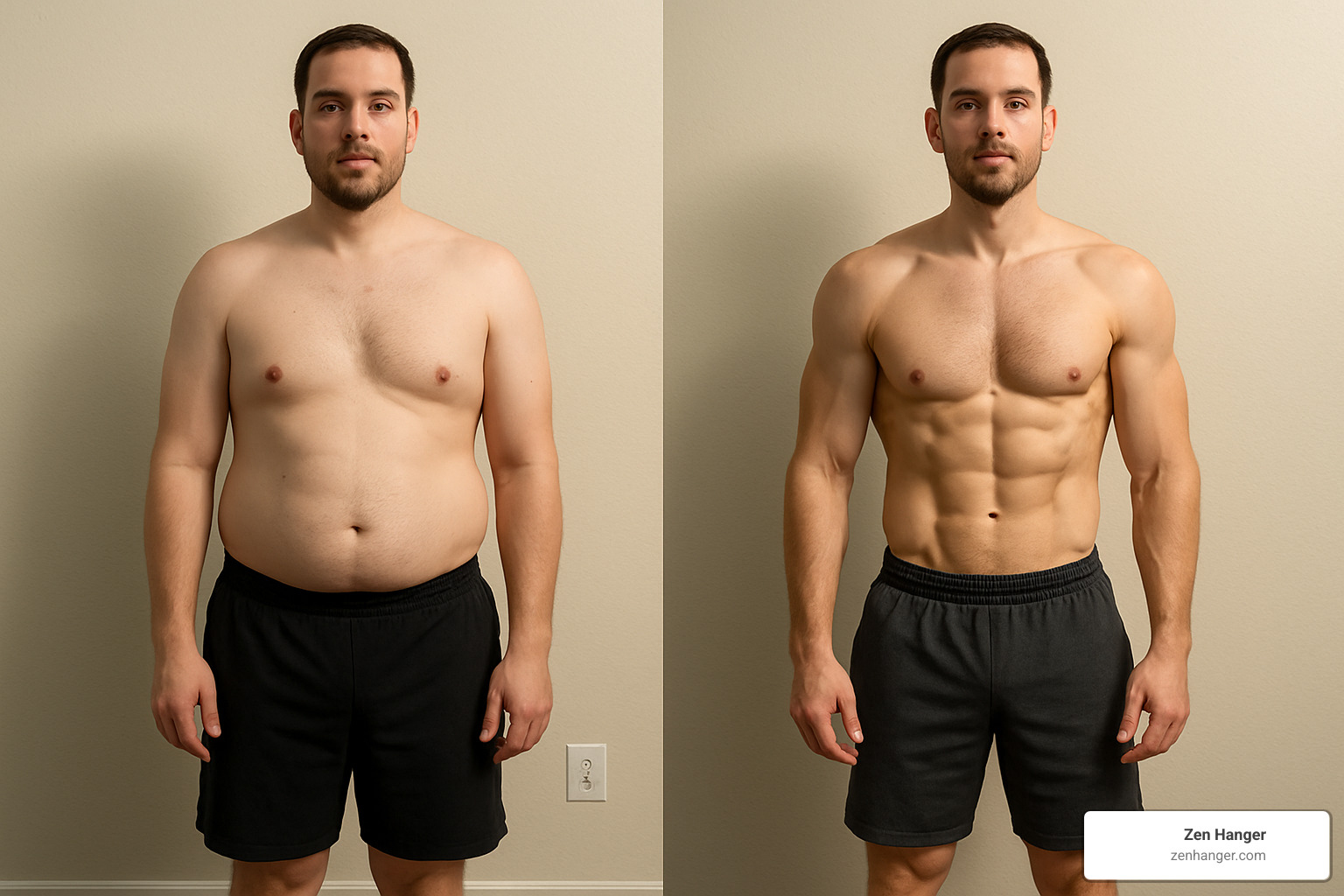
Progress photos can reveal subtle changes that measurements might miss—improved muscle definition, better proportions, changes in posture, or visual differences in symmetry.
Putting It All Together & Next Steps
The secret to truly understanding your progress lies in using multiple measurement methods. It's like having different camera angles to capture the complete picture of your journey. Here's a practical schedule I've seen work wonders for my clients:
Weekly:
- Weight (same day, same time, same conditions)
- Strength tracking (record all workouts)
Bi-weekly:
- Circumference measurements
- Progress photos
Monthly:
- Body composition assessment (body fat percentage)
- Calculate lean body mass changes
Every 6-8 weeks:
- More comprehensive strength testing (1RM or rep max tests)
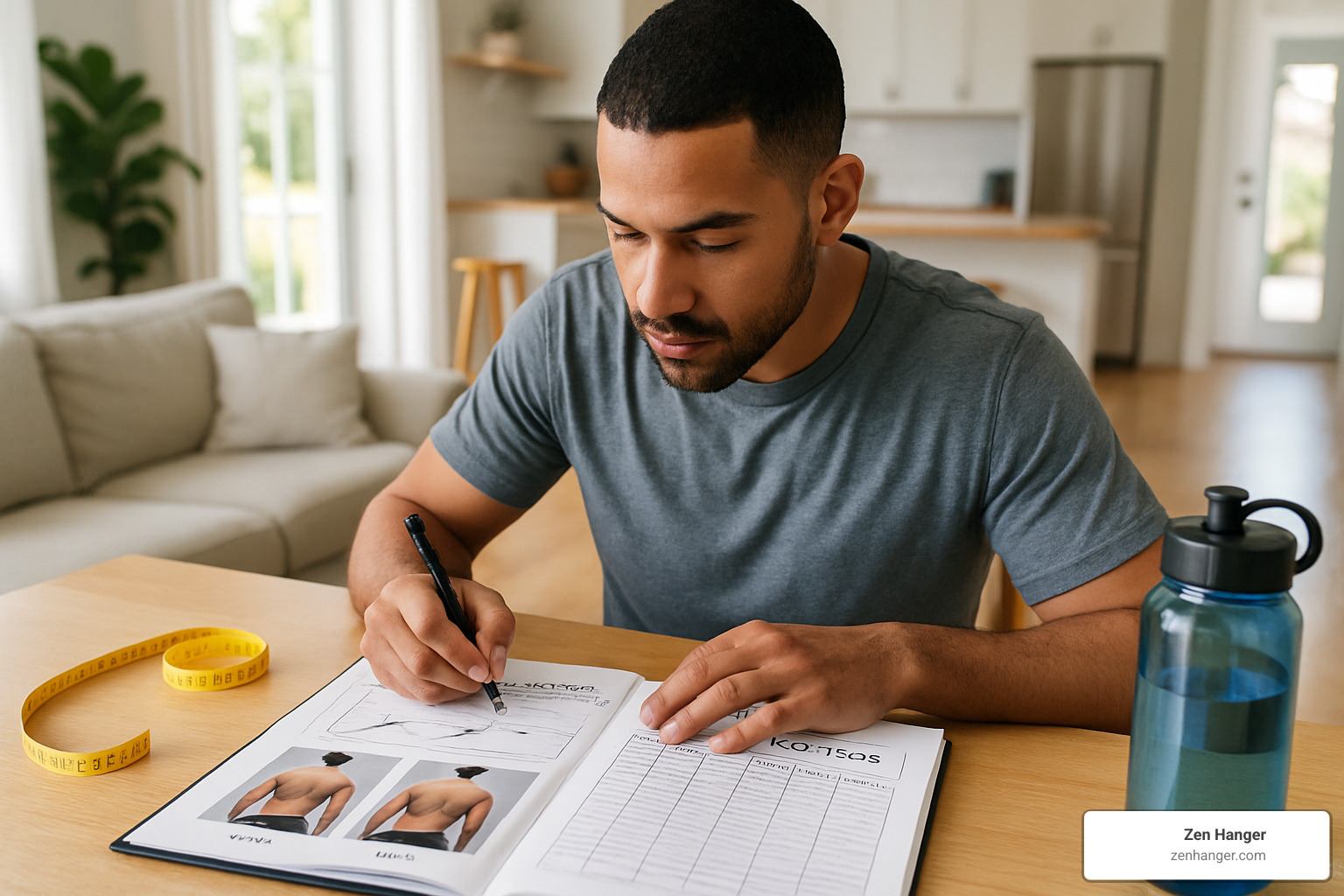
At Zen Hanger, we've found that this combined approach gives our clients the most accurate feedback on their journey. Whether you're building muscle or working toward personal improvement goals, seeing progress from different angles keeps motivation high when one measurement might temporarily plateau.
Let's talk expectations—because unrealistic ones are motivation killers. The research shows some pretty clear patterns for natural progress:
For muscle and strength, beginners might see 1-2 pounds of new muscle monthly with 10-15% strength increases. Intermediate trainers typically gain 0.5-1 pound of muscle per month with 5-10% strength improvements. Advanced folks might only add 0.25-0.5 pounds monthly with 2-5% strength gains.
For personal improvement goals, progress varies significantly based on your individual factors, consistency, and methods. Many of our customers report noticeable improvements within 3-6 months of dedicated use.
Remember to celebrate the small wins! That half-inch increase in your arm measurement or 5% strength boost might seem modest today, but these gains compound beautifully over time.
Curious about natural improvement methods? We've got plenty of resources on natural enlargement methods that pair perfectly with the measurement techniques we've discussed.
Common Pitfalls & How to Measure Gains Consistently
Even the most dedicated among us can fall into measurement traps that skew our results. Here are the biggies I see all the time:
Inconsistent conditions can throw everything off. Your body weight and measurements fluctuate throughout the day based on meals, hydration, and even the time you measure. Morning measurements, after bathroom use but before breakfast, tend to be most consistent.
Switching measurement tools is like changing the rules mid-game. That new digital scale might read differently than your old one, making progress tracking impossible. Stick with the same tools.
Measuring too frequently can drive you crazy! Daily measurements will show normal fluctuations that might discourage you. Trust the process and stick to our recommended schedule.
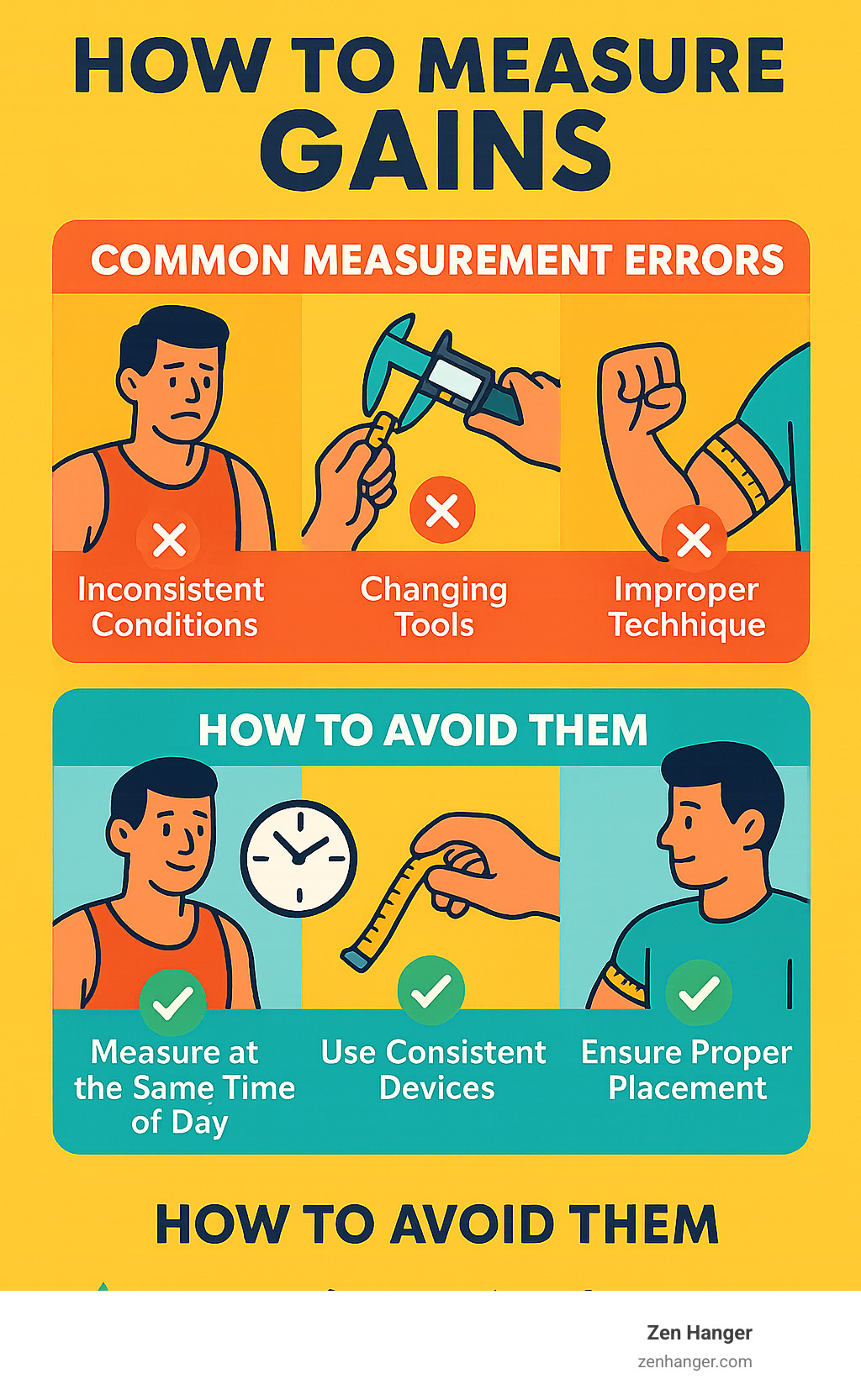
When to Seek Professional Guidance
While I'm all for self-sufficiency, sometimes calling in the pros makes all the difference:
If you've hit a stubborn plateau with no progress for 6-8 weeks despite doing everything right, a professional can spot what you're missing.
For the most accurate body composition analysis, consider treating yourself to a professional DEXA scan every 3-6 months. Yes, they cost $75-150, but the precision can be worth it for serious trainees.
A qualified trainer can assess your exercise form, ensuring you're performing movements correctly for maximum gains and injury prevention. This is especially valuable when starting new routines.
Struggling with your diet? A nutritionist can customize your eating plan to support your specific goals, whether building muscle or trimming fat.
Physical development—whether building muscle or personal improvement—is definitely a marathon, not a sprint. Consistent effort paired with accurate measurement creates a powerful feedback loop that keeps you moving forward. With patience and the right tracking methods, you'll not only make progress but have the concrete evidence to prove it to yourself.
For more information about proper measurement techniques, check out How Does Penis Length Measurement Work? on our website.
